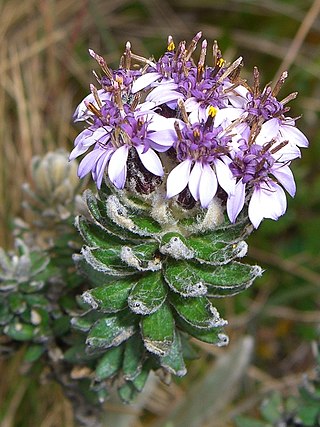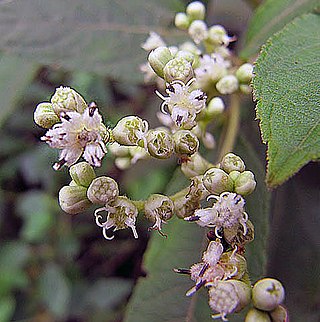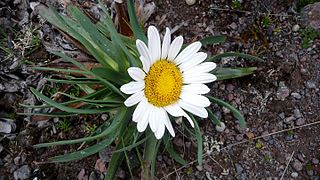
Ageratina, commonly known as snakeroot, is a genus of over 300 species of perennials and rounded shrubs in the family Asteraceae.

Conyza is a genus of flowering plants in the family Asteraceae.

Diplostephium is a genus of trees and shrubs in the family Asteraceae.

Clibadium is a genus of flowering plants in the family Asteraceae.

Dendrophorbium is a genus of South American flowering plants in the family Asteraceae.

Jungia is a genus of flowering plants in the family Asteraceae. It is native mostly to South America, with one widespread species extending its range into Central America and southern Mexico.

Munnozia is a genus of flowering plants in the family Asteraceae. It is centered in the Andes.

Mutisia is a genus of flowering plant in the tribe Mutisieae within the family Asteraceae. Mutisia has been named after José Celestino Mutis. It comprises about sixty species which can be found along the entire length of the Andes and in southern Brazil, Paraguay, Uruguay and northern Argentina.
Oligactis is a genus of South American flowering plants in the tribe Liabeae within the family Asteraceae.

Pentacalia is a genus of flowering plants in the family Asteraceae. About 34 members of this genus appear to be located in the South American county Ecuador, where they are threatened by habitat loss. The genus contains approximately two hundred species, which are distributed from Mexico to northern South America.

Viguiera is a genus of flowering plants in the family Asteraceae. It contains around 19–40 species, which are commonly known as goldeneyes and are native to the New World. These are herbs to bushy shrubs that bear yellow or orange daisy-like flowers.

Espeletia, commonly known as 'frailejones', is a genus of perennial subshrubs, in the family Asteraceae. The genus, which is native mainly to Colombia, Venezuela and Ecuador, was first formally described in 1808. The genus was named after the viceroy of New Granada, José Manuel de Ezpeleta.

Calea is a genus of flowering plants in the aster family, Asteraceae. They are distributed in tropical and subtropical regions in Mexico, Central America, and South America.

Werneria is a genus of South American plants in the groundsel tribe within the sunflower family.

Tridax is a genus of flowering plants in the family Asteraceae.
Mniodes is a genus of South American flowering plants in the tribe Gnaphalieae within the family Asteraceae.

Montanoa is a genus of flowering plants in the tribe Heliantheae, within the family Asteraceae.















